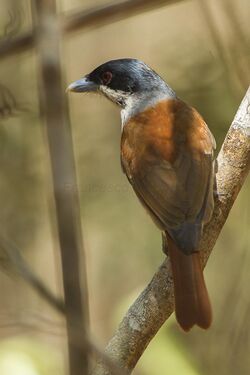Biology:Rufous vanga
| Rufous vanga | |
|---|---|

| |
| Scientific classification | |
| Domain: | Eukaryota |
| Kingdom: | Animalia |
| Phylum: | Chordata |
| Class: | Aves |
| Order: | Passeriformes |
| Family: | Vangidae |
| Genus: | Schetba Lesson, 1831 |
| Species: | S. rufa
|
| Binomial name | |
| Schetba rufa | |
| Synonyms | |
|
Lanius rufus Linnaeus, 1766 | |
The rufous vanga (Schetba rufa) is a species of bird in the family Vangidae. It is monotypic within the genus Schetba.[2] It is endemic to Madagascar , where its natural habitats are subtropical or tropical dry forest and subtropical or tropical moist lowland forest.[1]
In 1760 the French zoologist Mathurin Jacques Brisson included a description of the rufous vanga in his Ornithologie based on a specimen collected on the island of Madagascar . He used the French name La pie-griesche rousse de Madagascar and the Latin Lanius Madagascariensis rufus.[3] Although Brisson coined Latin names, these do not conform to the binomial system and are not recognised by the International Commission on Zoological Nomenclature.[4] When in 1766 the Swedish naturalist Carl Linnaeus updated his Systema Naturae for the twelfth edition, he added 240 species that had been previously described by Brisson.[4] One of these was the rufous vanga. Linnaeus included a brief description, coined the binomial name Lanius rufus and cited Brisson's work.[5] The rufous vanga is now the only species placed in the genus Schetba that was introduced by the French naturalist René Lesson in 1831.[6]
Two subspecies are recognised:[7]
- S. r. rufa (Linnaeus, 1766) – north and east Madagascar
- S. r. occidentalis Delacour, 1931 – west Madagascar
References
- ↑ 1.0 1.1 BirdLife International (2016). "Schetba rufa". IUCN Red List of Threatened Species 2016: e.T22708016A94145980. doi:10.2305/IUCN.UK.2016-3.RLTS.T22708016A94145980.en. https://www.iucnredlist.org/species/22708016/94145980. Retrieved 11 November 2021.
- ↑ "ITIS Report: Schetba". Integrated Taxonomic Information System. https://www.itis.gov/servlet/SingleRpt/SingleRpt?search_topic=TSN&search_value=558205.
- ↑ Brisson, Mathurin Jacques (1760) (in French, Latin). Ornithologie, ou, Méthode contenant la division des oiseaux en ordres, sections, genres, especes & leurs variétés. 2. Paris: Jean-Baptiste Bauche. pp. 178–180, Plate 18 fig 4. https://biodiversitylibrary.org/page/36011402. The two stars (**) at the start of the section indicates that Brisson based his description on the examination of a specimen.
- ↑ 4.0 4.1 Allen, J.A. (1910). "Collation of Brisson's genera of birds with those of Linnaeus". Bulletin of the American Museum of Natural History 28: 317–335.
- ↑ Linnaeus, Carl (1766) (in Latin). Systema naturae : per regna tria natura, secundum classes, ordines, genera, species, cum characteribus, differentiis, synonymis, locis. 1, Part 1 (12th ed.). Holmiae (Stockholm): Laurentii Salvii. p. 137. https://biodiversitylibrary.org/page/42946333.
- ↑ Lesson, René (1831) (in French). Traité d'Ornithologie, ou Tableau Méthodique. Paris: F.G. Levrault. p. 374. https://biodiversitylibrary.org/page/35997358.
- ↑ Gill, Frank; Donsker, David, eds (2018). "Batises, woodshrikes, bushshrikes, vangas". World Bird List Version 8.1. International Ornithologists' Union. http://www.worldbirdnames.org/bow/batises/.
External links
Wikidata ☰ Q609883 entry
 |


